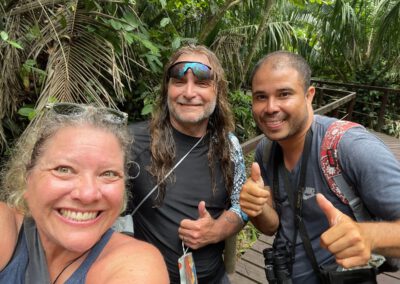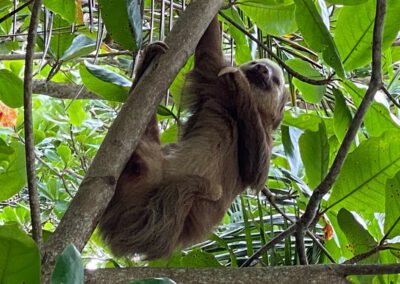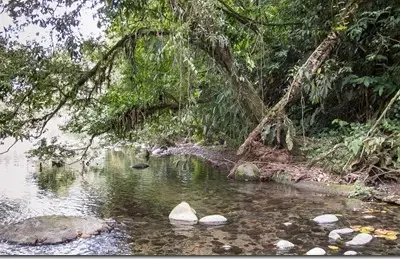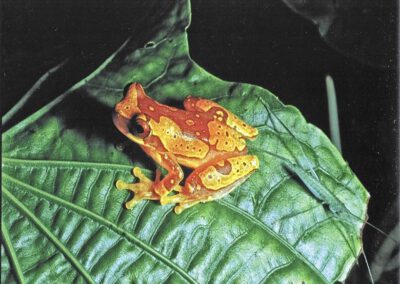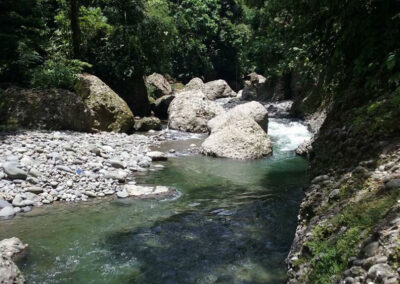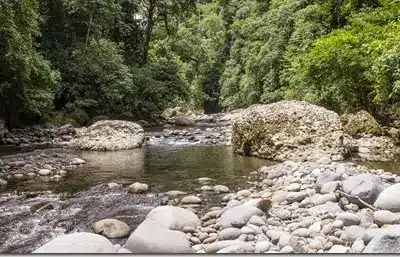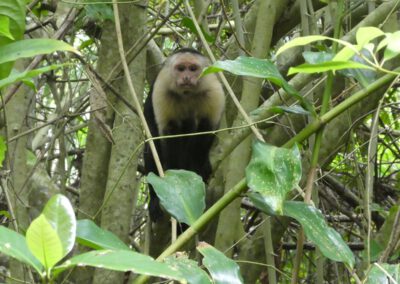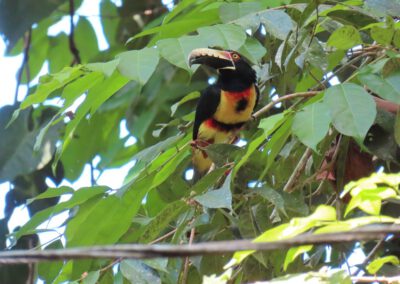Contents
Hitoy Cerere Biological Reserve | Unesco Culture Inheritage
Undeveloped and virtually unexplored, the Hitoy Cerere is only for the most adventurous and fit hikers; this biological reserve is one of the most remote territories in the country’s eastern portion. There are several unexplored portions along the upper Talamanca Mountains. A ranger station is at the entrance, but no other facilities exist.
The reserve has a humid tropical and a mountain pluvial forest. Just getting to the Hitoy-Cerere Reserve can make for an enjoyable all-day adventure; its rugged terrain and the uneven terrain combined with the heavy rainfall.
Hitoy Cerere Biological Reserve Tour – What to expect?
Our meeting point is at 09:00 at the Penshurst Gas Station, conveniently between Cahuita and Puerto Limon.
Once we reach Penshurst, we embark on an hour-long journey that leads us through vast banana plantations, charming villages, rolling hills, and unpaved roads. The reserve is neighbored by some of the nation’s most secluded indigenous villages, including Talamanca, Bribri, and Telire.
Upon arrival, our first destination is the Ranger Station at the Hitoy-Cerere Biological Reserve, where you can purchase snacks. Subsequently, we explore the trails, traversing two distinct life zones and a transitional area between them: the highly humid tropical forest and the premontane rainforest. Along the way, we pause at one of the waterfalls to refresh ourselves with a quick dip and enjoy some leisure time. Here, we indulge in fresh fruits and snacks to rejuvenate.
Continuing our journey, we venture into the premontane rainforest. Due to the region’s copious rainfall, the terrain is crisscrossed by numerous rocky rivers featuring swift currents and imposing waterfalls, some of which reach impressive heights. The name “Hitoy-Cerere” finds its origins in two indigenous Bribri words: “Hitoy,” symbolizing the green “blanket” enveloping everything in the park, and “Cerere,” signifying clear waters.
As elaborated below, we’ll have the opportunity to encounter abundant wildlife, diverse flora, and fauna.
To conclude our excursion, all that remains is to take a refreshing swim or leisurely linger while awaiting the return transportation that will bring us back to civilization. The hike itself covers approximately 4 hours and is well-suited for fit hikers.
Duration
Approximately: 6 hours.
What to bring with you
Closed footwear, sunscreen, drinking water, swimsuit for river and waterfall, towel, mosquito spray, and eventually, rain cover or long sleeves. Making a valid weather forecast can sometimes be challenging. Fresh fruits are included. As there are not a lot of facilities, bring a snack with you [there is also a Ranger Station – though no restaurants]. The hike is fantastic but can be steep, and you need the energy.
Our Tour guides
Our guides are genuinely local and experienced tour professionals. They harbor a sincere and profound passion for nature and wildlife, deeply respect Costa Rican culture, are thoroughly prepared, and are licensed by the ICT (Costa Rican Tourism Institute).
Pricing
For pricing, see the shop product page and the “Additional Information” Tab; minimum group size [adults] = four persons.
What is Included
The price includes fresh fruits, an experienced tour guide, and the entrance fee of the Hitoy Cerere Biological Reserve.
What is Excluded
The Tour is based upon own transport [upon request transport can be arranged].
Meeting Point and Direction | Transport
The designated rendezvous spot is the Penshurt Gas Station, situated a short distance from Cahuita, along the route to Puerto Limon. It takes approximately one hour by car to reach the Hitoy Cerere Biological Reserve from the village ‘Penshurt’.
Please note that transportation is not provided as part of the tour package, but the entrance fees for the reserve are included. If needed, we can arrange transport and offer the option of hotel pickup ‘upon request.’
About Hitoy Cerere Biological Reserve – Province of Limón
The Hitoy Cerere Biological Reserve in Costa Rica was established in 1978, serving as a protective haven for over 40 species, including those classified as endangered. Nestled amidst the hills of the Talamanca mountain range within the Caribbean Brunca region, this remarkable area can be found in the Province of Limón. It lies between the Estrella and Telire Rivers, forming part of the Talamanca mountain range, and is aptly named after the Hitoy and Cerere rivers, which flow through the reserve.
This reserve safeguards a remote and largely unexplored rainforest terrain. It falls within the domain of the La Amistad Caribbean Conservation area and earned recognition as a UNESCO World Heritage Site in 1993. The reserve’s landscape is characterized by ruggedness, owing to its mountainous location, and is further shaped by frequent, heavy rainfall, creating a complex network of waterways. Additionally, the reserve is home to various water torrents, resulting in rocky formations and impressive waterfalls.
Despite these unique features that create a striking contrast, the Hitoy-Cerere Biological Reserve remains relatively understudied and unvisited, primarily due to its challenging accessibility. Once you manage to reach the reserve, you can explore its lush rainforests and relish the opportunity to observe orchids thriving near towering trees.
This reserve remains relatively unknown, mainly because of its extreme inaccessibility, leading to limited visitation. It undeniably ranks among Costa Rica’s most humid locations, with “Hitoy” translating to “wool” in the Bribri Indian language, referencing the mosses covering the stones, and “Lamartine” alluding to “clear waters.” Notably, the reserve is distinguished by its rich and slightly less elusive wildlife compared to more frequently visited parks. However, patience is key, as the most extraordinary specimens tend to reside in the forest’s upper reaches and can be challenging to observe.
The Hitoy Cerere Biological Reserve comprises two distinct life zones with a transitional area between them: the highly humid tropical forest and the premontane rainforest. The region experiences substantial rainfall, resulting in the crisscrossing of numerous rocky rivers characterized by their swiftness and the presence of waterfalls, some of which reach considerable heights. The reserve’s name originates from two indigenous Bribri words: “Hitoy,” which alludes to the green “blanket” enveloping the park, and “Cerere,” signifying clear waters, in reference to the abundance of this element in the vicinity. Owing to the challenging geological formation of its terrain, along with its very humid climate, this reserve has not been extensively researched and remains relatively unvisited.
In the higher elevations of the Hitoy Cerere Biological Reserve, you’ll encounter lush evergreen highlands adorned with morning dew. Conversely, in the lowland rainforest, raindrops continue to trickle to the forest floor even hours after the last drizzle. The intervals between showers are typically brief, as the reserve annually receives lots of rainfall, solidifying its status as one of Costa Rica’s most luxuriant and vibrant reserves. In fact, the name “Hitoy Cerere” originates from the Bribri language, signifying “wooly clear water,” aptly capturing the idea that sustained rainfall is a constant in this expansive 20,000-acre reserve.
History and the Indigenous Villages
The Hitoy Cerere Biological Reserve is a protected natural area located in Costa Rica, specifically in the southern part of the country near the border with Panama. It is part of the larger La Amistad International Park, which is a UNESCO World Heritage Site shared between Costa Rica and Panama.
This reserve is known for its rich biodiversity, pristine rainforests, and its significance in conserving the natural heritage of the region. While the primary focus of the reserve is on its biological diversity, the culture and history of the indigenous tribes in the area are also of great importance.
Bribri People
The Bribri people are one of the indigenous groups residing in the region of the Hitoy Cerere Biological Reserve and La Amistad. They have a rich cultural heritage that includes traditional knowledge about the rainforest, medicinal plants, and agriculture. The Bribri language is still spoken by the community, and they have their own traditional governance systems.
Cabo Verde People
The Cabécar people are another indigenous group in the area. Like the Bribri, they have their own language and cultural practices. They have a deep connection to the land and its resources and have traditionally lived in harmony with the rainforest.
Culture and Traditions
Both the Bribri and Cabécar peoples have a strong cultural connection to the natural environment. They believe in the importance of conserving the rainforest and preserving their traditional way of life. Their culture is characterized by traditional music, dances, and ceremonies, often related to their spiritual beliefs and practices.
History
The history of the indigenous tribes in the region dates back centuries, long before the arrival of European colonizers in the Americas. These tribes have inhabited the rainforests of what is now Costa Rica and Panama for generations. With the arrival of the Spanish in the 16th century, the indigenous populations faced significant challenges, including forced labor and the spread of diseases, which had devastating effects on their communities.
In recent history, there have been efforts to protect the rights and territories of indigenous communities in the region, including the establishment of protected areas like the Hitoy Cerere Biological Reserve and the recognition of indigenous land rights. However, these communities still face challenges related to land encroachment, deforestation, and access to basic services.
The Hitoy Cerere Biological Reserve plays a crucial role in preserving the natural environment that these indigenous communities depend on for their cultural and physical well-being. Efforts are made to involve local indigenous communities in the management and conservation of the reserve, respecting their traditional knowledge and practices.
Visitors to the Hitoy Cerere Biological Reserve can learn about the cultural heritage of these indigenous communities, explore the lush rainforests, and appreciate the importance of preserving both the natural and cultural diversity of the region.
Wildlife, Flora and Faunca
The Hitoy-Cerere Reserve showcases a vibrant tropical landscape encompassing humid tropical and mountain pluvial forests. Embarking on a journey to this reserve promises an enthralling day-long adventure, thanks to its rugged and uneven terrain, remarkable annual rainfall of 5000mm, and the absence of a dry season, rendering it a challenging destination primarily appealing to devoted naturalists.
A recommended approach for entering the reserve involves trekking along the upstream riverbeds, offering opportunities to glimpse the strikingly patterned Sunbittern, a bird commonly found near tropical streams.
The reserve draws its name from its principal river basins, the Hitoy and the Cerere Rivers, derived from the Bribrí language. In this context, “hitoy” translates to “moss-covered,” while “cerere” signifies “clear waters.” The habitat comprises dense tropical rainforests, where every tree is adorned with epiphytes, bromeliads, orchids, and lianas.
Costa Rica’s region is renowned for its rich biodiversity, including diverse large wild cat species like jaguars. Additionally, it is home to white-faced and howler monkeys, tapirs, peccaries, rabbits, anteaters, white-faced monkeys, raccoons, coatis, squirrels, sloths, pacas, deer, agoutis, and armadillos. Bird enthusiasts will also revel in the presence of over 300 bird species and more than 70 amphibian and reptile species.
The reserve’s frogs and toads, including poison dart; red poisoned frogs, and numerous other species, hold a particular allure. Noteworthy creatures include cherepos, gallegos, chirbalas, and snakes. Invertebrates inhabiting this area are bullet and leaf-cut army ants, large dragonflies, red butterflies, metallic-colored bees, and beetles. Expect challenging hiking conditions, as the trails here are not well-maintained, and uphill sections can be demanding.
On the way to the reserve, you’ll encounter vegetation and trees adorned with the colonial nests of Montezuma and Oropendolas, prominent oriole family members boasting vibrant yellow tails. These nests are easily recognizable due to the dozens of hanging pouches expertly woven by these birds. Furthermore, you’ll encounter majestic forest trees such as javillos, espavels, aguacatillos, ojoches, and guayabones, contributing to the vitality of the canopy. Although more than 380 plant species have been identified in the reserve, this number continues to grow.
Within the forest, you may have the opportunity to observe remarkable species like the Squirrel Cuckoo, toucans, and parrots. Notably, this reserve stands as one of the last strongholds for the critically endangered Harpy Eagle.
Hitoy Cerere Biological Reserve | Unexplored Diamant in Nature
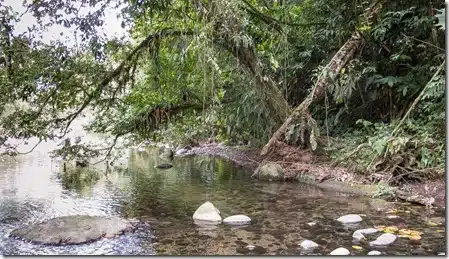


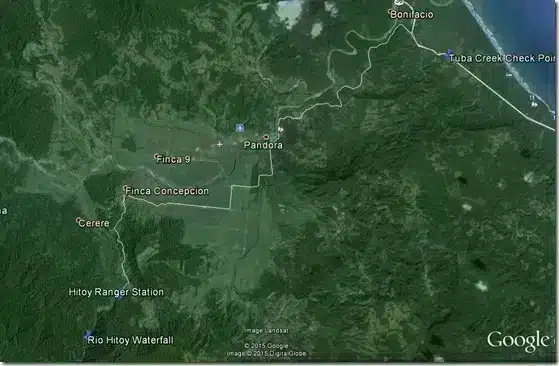
Take your camera – Make your Own Video Memory
The video is made by Mauricio Calderón during an astonishing hike at Hitoy Cerere Biological Reserve. Although the park is quite unknown yet, it is absolutely worthwhile for fit people to enjoy the wildlife, flora, and fauna.


